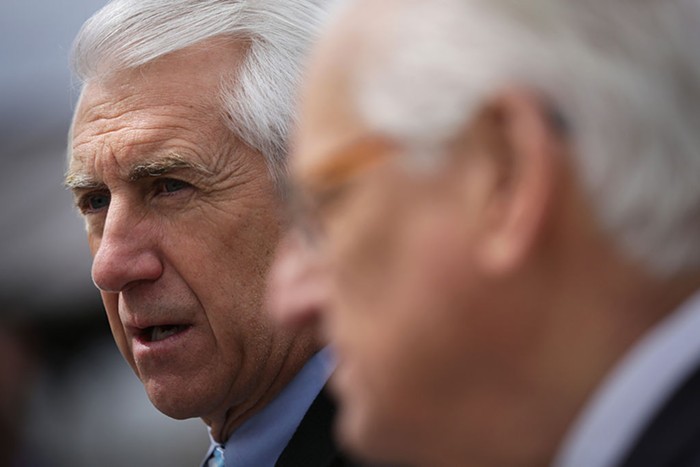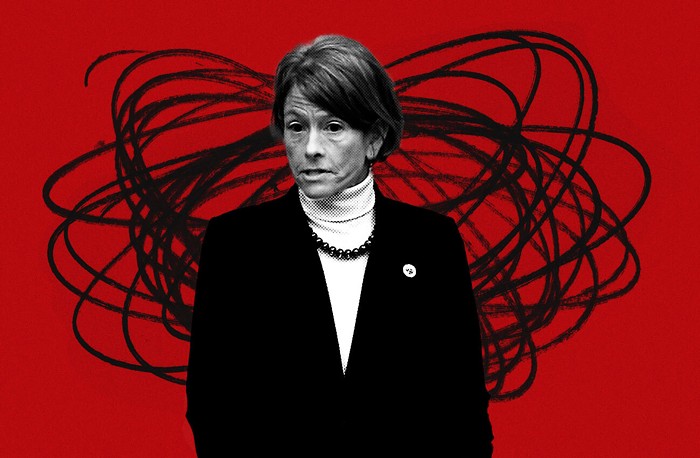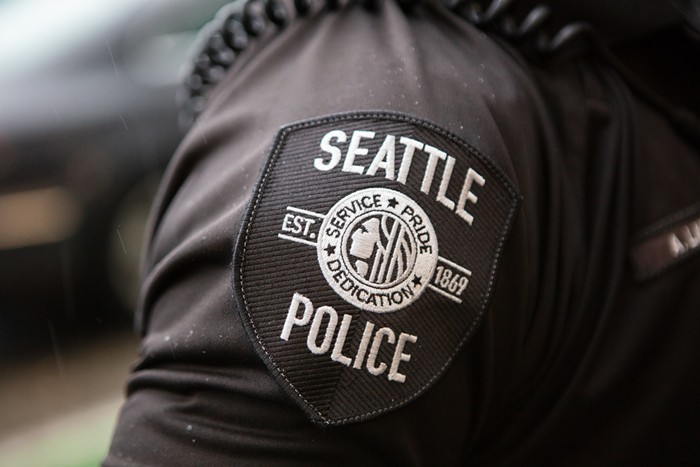Southcenter Mall is an ordinary, mid-sized structure that when seen from the busy I-5/I-405 junction in Tukwila appears to be crowned by Mt. Rainier. Saturated by 20 million shoppers annually, the mall presently contains 170 shops and vendors, one of which is GW Portrait Studio, whose owner offers drawings and sketches to people who, bored with the instantly produced and instantly deleted images on their cell phones, feel the need to be captured by the hand of a living artist.
The sample portraits that decorate GW Portrait's cart reflect the colors of the consumers who visit Southcenter Mall. There are portraits of ordinary folks (white American families, black American lovers, Asian-American buddies) amongst portraits of the rich and famous (Eminem, Ichiro, Bruce Lee, Martin Luther King Jr., Michael Jackson, Mother Teresa). The cart is near the middle of the mall, under a row of massive skylights that on a sunny day transform the length of specialty shops, imported palm trees, and bright banners into a racial paradise.
"They come from all types of ethnicities. Asian, Caucasian, black--we like to work for everybody," says Jin, the artist who owns and runs GW Portrait. Originally from Shanghai, Jin began the business two years ago after moving to Seattle from California. "I came to America a long time ago, and been drawing for a long time," she says. "School inspired me to draw. Some in Shanghai, some in California. Been doing it all my life." Her main business is in sketches, which are popular because they are quick and cheap. When asked about which race she draws the most, she responds, "I [never thought] about this question before. The mall is a big shopping area, so many different people. I never thought of just one ethnicity."
Southcenter Mall, which opened in 1968 and is in the process of being expanded, is nothing less than the realization of our soon-to-arrive American future. A walk through the mall (from its west entrance, where Nordstrom is located, to its east entrance, where recently King County opened a library) will, if your eyes are unaccustomed to seeing more than one race at a time, make you dizzy. Your sense of who you are, of what Seattle means, is instantly obliterated by the cacophony of consumers who are seemingly from every part of the world.
The uninitiated, the person who has never walked into this mall, will imagine, for the sake of comprehension, that different parts of it have been colonized by specific races: that the area around the Rainforest Cafe (with its talking trees, its stuffed animals, its stars twinkling over dining tables) is favored by Russians; that JCPenney (which is filled with everything made in the Third World) is monopolized by black Africans, and the light-flooded food court is dominated by Mexicans. Such sectioning would be comforting to both black and white sensibilities, as it would mirror the way neighborhoods in American cities are organized. But nothing of the sort has happened at Southcenter. Not one ethnic group has claimed a single part of this mall. Every race is everywhere. And so there isn't a majority that you can identify with or define yourself in opposition to. The global gates of consumption have finally been opened, and the heave and swells of the crowd that flows through the main passage and circulates the floors in massive department stores changes color like an estuary under an iridescent sun.
According to the mall's marketing director, Kristin Flores, Southcenter services the race-rich cities and neighborhoods of Tukwila, SeaTac, Renton, and Southeast Seattle--a neighborhood that is recognized as one of the most integrated in North America. Walking around Southcenter, one can't but ponder other Seattle neighborhoods. For instance, Fremont. For all its leftist politics and activism, the northern neighborhood of Fremont (which is 89 percent white, according to the last U.S. census) has utterly failed to achieve the kind of diversity that thrives in this mall where Jin runs her small business. In this ruthlessly capitalist space, one whose root principles (private property, free enterprise, corporate financing) would make any Republican feel at home and any Fremont Solstice Parade-goer sick, we have what every Fremont lefty supports in theory but has failed to realize in practice: true racial diversity. Multiculturalism in a place like Fremont is all talk; at Southcenter Mall it is all action.
To this day, when publications like Seattle Magazine talk about Seattle, what they really have in mind are neighborhoods like Fremont, which are white. Out of habit, out of laziness, it is standard for whites in the north (who usually speak for our city) to describe Seattle as a white city; but go to South King County (population 120,000), to Southcenter Mall (20 million visitors per year), or to Southeast Seattle (population 120,000), and this is not the case. These places are racially integrated--a social environment that year after year is becoming less and less exceptional in Seattle. (In 1960, Seattle was 92 percent white; now it is 67 percent, a figure that according to indicators will continue to fall as we go deeper into the 21st century.)
The Failure of Integration
Exactly 50 years after the Supreme Court decision that launched the civil rights movement, Brown v. Board of Education (it determined that separate schooling for blacks and whites violated the 14th Amendment), Georgetown University professor Sheryll Cashin published a book called The Failures of Integration: How Race and Class Are Undermining the American Dream. In her opinion, which is backed by considerable research, the United States remains--after all of the long marches, signed laws, and powerful speeches--a segregated society. Whites still live in white neighborhoods and blacks still live in black neighborhoods.
The civil rights project certainly improved the lives of black Americans--more jobs are now open to them, and there has been a sharp rise in their standard of living, with the '90s producing the richest black society in the history of the modern world. At one heady point during the boom years, black Americans, whose population stands at 36 million, had a spending power that was half a trillion dollars. But integration in the workplace has not led to integration of neighborhoods; at the end of a workday, blacks and whites return to neighborhoods populated by their own kind.
Cashin, who is black and lives in a neighborhood in the District of Columbia that is 72 percent black and 21 percent white, argues that black Americans are less interested in Martin Luther King Jr.'s dream of a color-blind society due to "integration exhaustion." Fatigued by the long struggle for recognition and acceptance in American society, they now favor the relative ease of living in black neighborhoods. "African Americans are increasingly reluctant to move into neighborhoods without a significant black presence," Cashin writes. "They prefer places that are recognized as being welcoming to blacks and less willing than in the past to be integration pioneers and move into neighborhoods that might be hostile to their presence."
So the spirit of Brown, the spirit of "we shall overcome," is a thing of the past. Blacks are tired of fighting the unremitting forces of racism, and, unlike 50 years ago when moving out of the ghetto and into the mainstream meant everything, they just want to be left alone and go about their day-to-day business without racial hassles. "I have to work around them all day, [and so] by the time I come home I don't want to deal with white people anymore," says a black writer, Sam Fulwood, who is quoted in Cashin's book. And the choice for upwardly mobile blacks is no longer limited to the ghetto or an upscale white neighborhood. Increasingly, upwardly mobile blacks have the option of moving to upscale black neighborhoods.
A Kingian intellectual ("I have a dream") of the first order, Cashin believes the failure of integration is bad for America. To begin with, it goes against the founding principles of the country, and frays "the social contract." It also produces a "[politics] which heavily favors the desires of white suburban voters and implies that they need not contribute to the larger society." In a segregated America, blacks lose out on opportunities that should be open to them as citizens; as for whites, segregation comes at a very high cost. Working and middle-class whites pay a steep price to be with their own kind. "The average cost of a home for a white person is 43 percent more than that of a black person with the same income," Cashin writes. Buying expensive houses in white areas to be closer to upper-class whites is connected with "bankruptcy trends" among working and middle-class whites, who in a household with two working parents will typically devote an entire salary to mortgage payments for a home in a "good neighborhood."
The Future Is Southeast
Cashin doesn't believe that black/white neighborhoods like West Mount Airy in Philadelphia (50 percent black, 44 percent white, 2 percent Latino) are the solution to the integration problem; they are too restricted in the sense that they manage to confront or resolve only one (and indeed the oldest and most visible) aspect of American racism. "Biracial environments," she writes in the chapter "The Case for Integration," "...[are] fraught with peril, and a tortured racial history, when the relational dynamic is between blacks and whites." What she prefers instead are neighborhoods with three or more races; neighborhoods that are liberated from the tyranny of the black/white binary.
In her book, Cashin points to Southeast Seattle (24 percent black, 29 percent white, 34 percent Asian, 6 percent Latino) as an excellent example of this type of neighborhood. And because such neighborhoods are rare in America, and because they represent a kind of Kingian paradise, she calls them "multiracial islands."
"A different, perhaps more common scenario for integration in the future," she writes in one of two optimistic chapters in this generally gloomy book, "is the multiracial island. Southeast Seattle embodies this possibility."
According to professors Andrew Gordon, Hubert Locke, and Cy Ulberg's influential 1997 paper "Ethnic Diversity in Southeast Seattle," Southeast Seattle begins with I-90, runs between I-5 and Lake Washington, and is terminated by the city of Renton. (I prefer to start a little farther north, in the Central District--East Jefferson Street to be precise. The C.D., whose black population has dropped from 51 percent in 1990 to 32 percent today, seems to have much in common with Northeast Portland, which, as Cashin puts it, has seen an "influx of mostly childless whites." But white Americans, childless or otherwise, are not the only ones moving into the Central District. Black Africans, Asians, and Latinos have all significantly increased their numbers in that area.) Southeast Seattle has an estimated population of 120,000, and Seattle as a whole has an estimated population of 570,000. What this means is that roughly one out of every five people residing in this city lives in an environment that is radically multiracial. For many Seattleites, racial diversity is not a progressive ideal but their defining reality; here, a black American family shares a street with Latinos, white Americans, and Vietnamese immigrants.
Happy Accidents
"I've actually been to Southeast Seattle," Cashin tells me over the phone from her home in Washington, D.C., "but at the time I stayed there I didn't realize I was going to be writing a book about this subject five years later. But while I was there I noticed the variety and also that there was lots of mixing going on. Mixed couples, mixed kids. I was very impressed. So when I started working on the book, and discovered a study ["Ethnic Diversity in Southeast Seattle"] that had been done on the racially integrated community, I decided to include it in my book."
Neighborhoods like Southeast Seattle are not the result of social engineering. "Because they're not integrated by design," she explains, "they're accidental. They happen because of happy accidents. In Southeast Seattle there's a mix of housing--a mixture of housing which has the benefit of creating class integration, and often class integration is necessary in order to create racial integration." So in Southeast Seattle "income diversity," as Gordon, Locke, and Ulberg put it, was made possible by "housing diversity," or the wide range of home prices, which itself is made possible by streets dead-ending at expensive lakefront properties and some homes on hills offering spectacular views. It was also made possible by the growth and expansion of the population on Beacon Hill (which had been settled by Asians in the early 1900s), and the southward movement of black Americans from the Central District (which has had black American clusters for most, if not all, of the 20th century). Then there was the arrival of immigrants from the most impoverished Third World countries (particularly in the '90s). Impecunious and often ignorant of English, few of these immigrants could dream of living in the generally expensive north--and for the most part their dreams weren't really wanted there. They had no other choice but to settle and set up their small businesses and community organizations in Southeast Seattle, and also further down south, in Renton and Tukwila, whose majority white populations are very soon to be reduced to minority status by the steady invasion of black and brown and yellow forces.
"We can learn from accidents like Southeast Seattle," Cashin concludes. "Learn and improve policies. It's a good thing to have policies that encourage middle-income homeowners to live in and among poor people. A lot of people vilify gentrification but, to me, if you're smart about it and try to cultivate neighborhoods that truly are mixed, rather than pushing poor people out, you might be able to re-create some of the benefits that we [as black people] had of pre-civil-rights, Jim Crow communities. Economic integration."
What Cashin means by this, and what is central to the ideas in her book, is that class integration is the first step not only toward integrated neighborhoods but also a socially healthier way of American life. In the past, segregated neighborhoods like South Chicago were, despite all of their problems, actually vital because poor blacks lived with middle-class and rich blacks. With the economic gains made by the civil rights movement came black flight--black professionals and businesspeople fleeing to the suburbs (a pattern that found its most representative moment in 1972 with Motown's abandonment of the streets of Detroit for the palm trees of L.A.). As poverty scholar William Julius Wilson explains in his influential book When Work Disappears, in the '40s over 70 percent of the residents in South Chicago were regularly employed; in the '80s, only 25 percent of residents were regularly employed. Much of that decline was the result of deindustrialization and the relocation of service jobs to suburbs and factory jobs to the Third World, but black flight also played a significant role in deepening the misery of this poor Chicago neighborhood. What Cashin wants to preserve from traditional black neighborhoods is class integration because, as studies have shown, "to achieve exceptional race mixing, class mixing must occur."
The Death of The Melting Pot
At the end of the musical The King of Jazz, which stars white jazz conductor Paul Whiteman, there is a scene that is staged to represent America's great melting pot. Different ethnicities in their national costumes walk up two opposing ramps that rise up to the top of a single big pot; one by one, they jump into the stew as Whiteman's orchestra plays jazz. The curious thing about the scene is this: The ethnic groups that jump into the pot are all from Europe--Scotsmen, Germans, Frenchmen, Russians, and Scandinavians. No blacks (who invented jazz!), or Chinese, or even Native Americans jump into the pot. This, however, was not an incorrect representation of what the melting pot is and always has been about. The function of the American melting pot is not to mix the races but to make white people out of Europeans from many different countries. Black Africans, for example, cannot assimilate in the conventional, melting-pot sense; they have the choice of either becoming black Americans or retaining their own culture. Similar restrictions apply to Southeast Asians and South Americans. Racially distinct characteristics prevent blacks Africans and Southeast Asians and South and Central Americans from removing their national costumes and becoming white, since our national costumes can't be removed. Race keeps us from melting.
The kind of mixing and multiculturalism that flourishes in Southeast Seattle has nothing to do with what Seattle Times writer Stuart Eskenazi idiotically called in a 2001 article on South King County "a melting pot of cultures." Such an expression is terribly misleading--these immigrants aren't becoming white; they are in the process of becoming something else, something that is without precedent in the history of this city and country. Nor does the Canadian term "mosaic" adequately describe the environment of multiracial islands. The expression "mosaic" is too polite, too calm, too nice, too Canadian. The best way to describe the life that inhabits Southeast Seattle and shops at Southcenter Mall is "the multitude."
"The multitude is a multiplicity, a plane of singularities, and an open set of relations," writes Michael Hardt and Antonio Negri in their popular book Empire. What they mean is that the multitude is too unruly to be boiled down into one substance. A melting pot produces one race, whereas the multitude is irreducible. "We should note that the concept of the people is very different from that of the multitude," writes Hardt and Negri. "The people... tends toward identity and homogeneity internally while posing its difference from and excluding what remains outside of it.... The concept of nation, people, and race are never very far apart."
Not "we the people," but "we the multitude" is what America must soon say, as cities like Seattle surrender to the throng of whites, blacks, Latinos, Asians--everybody. Fremont is America's past. The Southcenter Mall is America's future.



















